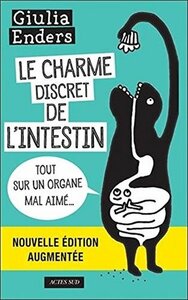You need to sign in or sign up before continuing.
Take a photo of a barcode or cover
informative
inspiring
fast-paced
funny
informative
lighthearted
medium-paced
I saw Giulia Enders give a TED talk online and I was hooked. She was entertaining, funny, and educational. Her book was the same. She makes the digestive track fascinating!!
We have a universe of microbes and bacteria within us - many with “minds” of their own. Our gut influences what we eat, what we crave, and how much weight we hold on to.
I found it interesting that humans give so much credit to the brain, but it is the gut that is in the thick of things. The gut has a remarkable system of nerves to gather information for the brain. It has a huge surface area that makes it the body‘s largest sensory organ. Everything else pales by comparison. The gut is a huge matrix sensing our inner life and workings.
I have never thought about all the figures of speech attached to the gut and our digestive organs. We can be “scared shitless” or “shitting ourselves” with fear. If we don’t complete a job we need to “get our ass in gear.” We “swallow our disappointment” and need time to “digest” a defeat. A nasty comment leaves a “bad taste in our mouth” and when we fall in love we get “butterflies in our stomach”. Our gut is like our second brain - but one that is under appreciated and often misunderstood.
This book is so interesting and written in a very accessible way. So much to learn (and digest!)
We have a universe of microbes and bacteria within us - many with “minds” of their own. Our gut influences what we eat, what we crave, and how much weight we hold on to.
I found it interesting that humans give so much credit to the brain, but it is the gut that is in the thick of things. The gut has a remarkable system of nerves to gather information for the brain. It has a huge surface area that makes it the body‘s largest sensory organ. Everything else pales by comparison. The gut is a huge matrix sensing our inner life and workings.
I have never thought about all the figures of speech attached to the gut and our digestive organs. We can be “scared shitless” or “shitting ourselves” with fear. If we don’t complete a job we need to “get our ass in gear.” We “swallow our disappointment” and need time to “digest” a defeat. A nasty comment leaves a “bad taste in our mouth” and when we fall in love we get “butterflies in our stomach”. Our gut is like our second brain - but one that is under appreciated and often misunderstood.
This book is so interesting and written in a very accessible way. So much to learn (and digest!)
J'ai pas l'impression de tout savoir sur le fonctionnement de l'intestin après avoir lu ce livre mais j'ai une meilleure conscience du fonctionnement d'un corps avec tous ces petites bestioles qui vivent en nous. Tout ne se passe pas dans la tête et je trouve qu'on a tendance à l'oublier et à négliger le corps, parfois même le nier.
informative
funny
informative
fast-paced
funny
hopeful
informative
fast-paced
Cách mà tác giả diễn giải kiến thức đối với mình là khá dễ hiểu, cộng thêm là có những hình minh họa vô cùng đơn giản nhưng thể hiện được đúng quá trình (cái đoạn bé phân đi qua đường ruột :>). Qua cuốn sách này mình cũng lượm lặt được một vài fact nhỏ như tư thế ngồi đi wc để cho cái "ai cũng biết là cái gì" dễ ra nhẩt, vi khuẩn không đáng sợ đến thế và nó giúp xây dựng hệ miễn dịch cho em bé như nào,...
informative
inspiring
reflective
medium-paced
To mogła być naprawdę świetna książka. Badania nad florą jelitową idą w naprawdę ciekawą stronę i wierzę, że szykuje się w związku z nimi kilka przełomów naukowych. Niestety, od drugiej strony do jelit zabiera się grupa zapaleńców z branży medycyny alternatywnej, dlatego wszystkie informacje medialne o odkryciach w tamtym rejonie należy traktować z ostrożnością. Altmedowcy uwielbiają jelita: Wakefield i jego "studia" nad autyzmem, preparaty do oczyszczania złogów kałowych, walka z glutenem - takich przykładów jest mnóstwo.
Czy "Gut" to książka rzetelna, czy altmedowo entuzjastyczna? Nie wiem, ale dwa razy złapałem autorkę na powtarzaniu mitów, co spowodowało, że straciłem do niej zaufanie:
1. Jako jedno z lekarstw na chorobę lokomocyjną wymienia akupunkturę: "P6! This is an acupuncture point that is now recognized by Western medicine as effective against nausea and vomiting. Its benefits have been proven in more than forty studies, including placebo-controlled trials. Doctors do not know how or why P6 works."
Spoiler alert: wyniki badań są mieszane, a same badania są niskiej jakości. Można iść spać, paradygmat nie runął.
2. "People have been eating probiotic bacteria since time immemorial. Without them, we would not exist. A group of South Americans had to learn that through bitter experience. They had the clever idea of taking pregnant women to the South Pole to have their babies. The plan was that the babies born there could stake a claim to any oil future reserves as natives of the region. The babies did not survive. They died soon after birth or on the way back to South America. The South Pole is so cold and germ-free that the infants simply did not get the bacteria they needed to survive. The normal temperatures and bacteria the babies encountered after leaving the Antarctic were enough to kill them".
To okropna historia! Dzieci poumierały chytrusom! Na szczęście jest nieprawdziwa. Owszem, w latach 70. Argentyńczycy wpadli na przebiegły pomysł wysłania ciężarnej kobiety na Antarktykę, żeby urodziła tam dziecko i żeby w ten sposób Argentyna mogła rościć sobie prawa do terytorium. Dziecko nazywa się Emilio Palma, ma 40 lat i czuje się dobrze. Urodziło się tam potem jeszcze kilkoro dzieci i nie udało mi się znaleźć informacji, żeby któreś zmarło, zwłaszcza od braku probiotyków.
Czy "Gut" to książka rzetelna, czy altmedowo entuzjastyczna? Nie wiem, ale dwa razy złapałem autorkę na powtarzaniu mitów, co spowodowało, że straciłem do niej zaufanie:
1. Jako jedno z lekarstw na chorobę lokomocyjną wymienia akupunkturę: "P6! This is an acupuncture point that is now recognized by Western medicine as effective against nausea and vomiting. Its benefits have been proven in more than forty studies, including placebo-controlled trials. Doctors do not know how or why P6 works."
Spoiler alert: wyniki badań są mieszane, a same badania są niskiej jakości. Można iść spać, paradygmat nie runął.
2. "People have been eating probiotic bacteria since time immemorial. Without them, we would not exist. A group of South Americans had to learn that through bitter experience. They had the clever idea of taking pregnant women to the South Pole to have their babies. The plan was that the babies born there could stake a claim to any oil future reserves as natives of the region. The babies did not survive. They died soon after birth or on the way back to South America. The South Pole is so cold and germ-free that the infants simply did not get the bacteria they needed to survive. The normal temperatures and bacteria the babies encountered after leaving the Antarctic were enough to kill them".
To okropna historia! Dzieci poumierały chytrusom! Na szczęście jest nieprawdziwa. Owszem, w latach 70. Argentyńczycy wpadli na przebiegły pomysł wysłania ciężarnej kobiety na Antarktykę, żeby urodziła tam dziecko i żeby w ten sposób Argentyna mogła rościć sobie prawa do terytorium. Dziecko nazywa się Emilio Palma, ma 40 lat i czuje się dobrze. Urodziło się tam potem jeszcze kilkoro dzieci i nie udało mi się znaleźć informacji, żeby któreś zmarło, zwłaszcza od braku probiotyków.
funny
informative
medium-paced



